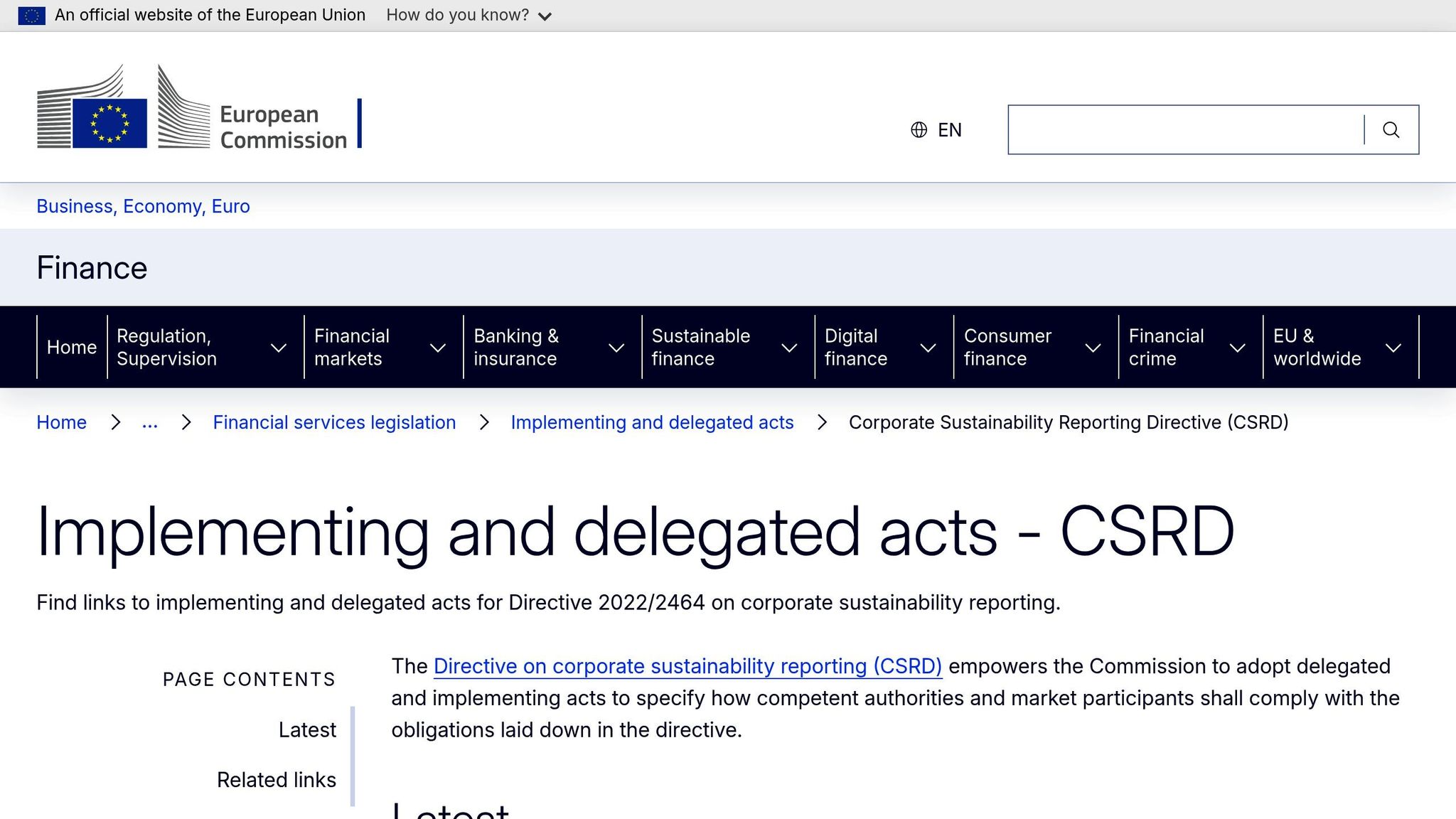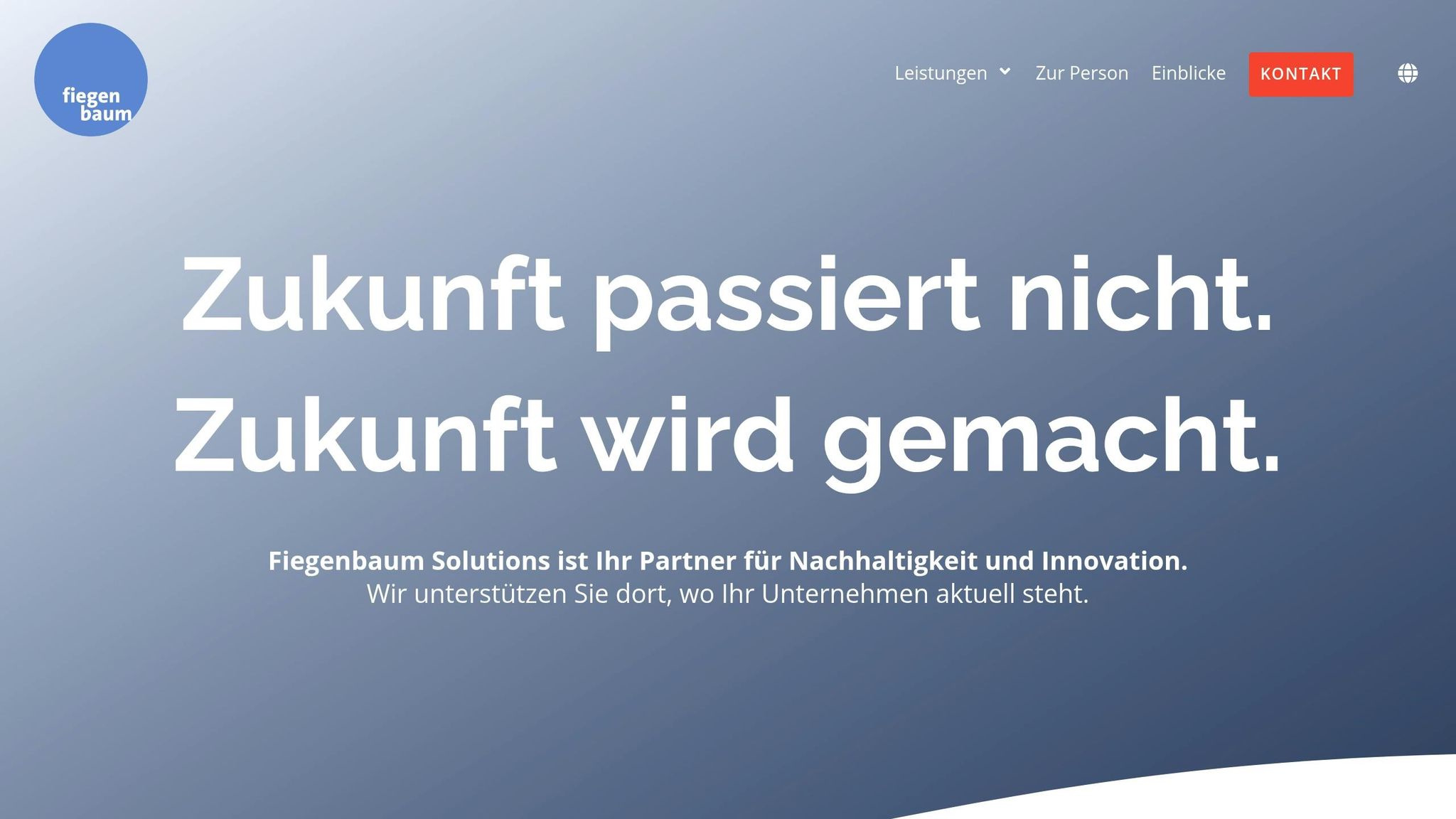ESRS E1 Implementation Guide: Mastering Climate Reporting Requirements
Want to know how to successfully implement the requirements of ESRS E1? This standard is central to...
By: Johannes Fiegenbaum on 9/19/25 9:41 PM

Starting in 2026, new standards for climate risk analyses will apply in the EU: ISO 14091 and the Corporate Sustainability Reporting Directive (CSRD). Companies – from large corporations to medium-sized enterprises – will be required to systematically assess and disclose physical and transitional climate risks. The goal is to create a unified foundation for reporting and climate risk management that both meets legal requirements and opens up economic opportunities.
The crucial point: Early preparation and cross-departmental collaboration facilitate implementation and secure competitive advantages.

ISO 14091 and the CSRD provide German companies with a clear structure for analyzing and reporting climate-related risks. While previously inconsistent approaches were often used, these standards create a unified basis for systematic climate risk analyses for the first time.
EN ISO 14091:2021 is titled "Adaptation to climate change – Guidelines for vulnerability, impacts and risk assessment". This European version of ISO 14091 provides German companies with a structured approach to assess climate-related vulnerabilities.
The framework pursues three essential goals: It helps companies recognize their vulnerabilities to climate change, minimize negative consequences, and simultaneously identify opportunities arising from these changes. Particularly interesting: The development of ISO 14091 was initiated partly in Germany.
A central tool within the framework are the so-called "Impact Chains". These show how climate-related hazards can influence business processes – directly or indirectly. Thus, ISO 14091 complements the CSRD requirements with a clear methodology.
The Corporate Sustainability Reporting Directive (CSRD) requires large and listed companies in Germany to report on Environmental, Social, and Governance (ESG) factors. In addition to presenting sustainability performance, risks that sustainability-relevant topics like climate change pose to the business must also be disclosed.
The reporting is based on the uniform ESRS criteria (European Sustainability Reporting Standards) of the EU. Additionally, companies are required to comply with the requirements of the EU Taxonomy Regulation, including comprehensive climate risk assessment. ISO 14091 provides a methodological foundation to efficiently implement these requirements.
ISO 14091 and the CSRD strategically complement each other: The CSRD creates the legal framework for reporting on climate risks and sustainability performance, while ISO 14091 provides the methodological basis for detailed climate risk assessments. The EU Taxonomy plays a connecting role, as it defines climate risk assessments as an essential component for demonstrating ecologically sustainable activities.
In practice, this means for German companies: First, the CSRD requirements serve as a legal guide. Subsequently, companies can use ISO 14091 to collect and analyze the required climate risk data. This data flows into both CSRD reporting and EU Taxonomy assessment.
With this integrated approach, robust and consistent analyses emerge that not only meet legal requirements but also ensure the quality and comparability of climate risk assessment.
After examining the theoretical foundations of ISO 14091 and the CSRD, we now turn to the practical implementation of climate risk analyses. The introduction of ISO 14091 follows a structured approach that is oriented to the specific requirements of German companies. The process is divided into preparation, implementation, and communication of results. This systematic approach helps companies identify climate risks in a targeted manner and develop adaptation strategies based on them.
In the next step, we show how you can efficiently collect and analyze climate data.
The first step of the analysis is to determine the lifespan of economic activities. Activities with a duration under or over ten years require different climate scenarios from the IPCC. Additionally, it's important to define specific investigation objects – such as production sites and their associated procurement and transport processes – to assess location-specific climate risks.
Official climate projections, for example from the German Weather Service (DWD), and regional climate models provide valuable data on potential weather extremes such as heavy rainfall, heat waves, or storms. The risks vary by location: companies in Bavaria face different challenges than operations in Schleswig-Holstein, while coastal regions must particularly consider storm surges and rising sea levels.
The vulnerability analysis aims to identify weaknesses in your processes and structures to minimize negative climate impacts while simultaneously recognizing potential opportunities. This precisely determines which areas, facilities, or groups of people are particularly affected by climate change.
This structured approach allows for comprehensive risk assessment. Production facilities can be tested for their sensitivity to extreme temperatures, while logistics centers are evaluated for flood risks. Both direct impacts – such as heat stress on employees – and indirect consequences like supply chain disruptions are considered.
A methodical approach reveals the connections between climatic hazards and their impacts on various business areas. Extreme heat periods can overload cooling systems in production halls, leading to production failures, delivery delays, and ultimately customer losses.
Many German companies use quantitative methods to assess the probability and damage potential of risks. These risks are then categorized as "low," "medium," or "high" to set priorities.
Based on this assessment, targeted adaptation and prevention strategies can now be developed.
Developing effective adaptation plans requires a long-term perspective and collaboration between various departments. Many climate adaptation measures require time and often involve significant investments.
"Climate protection is the most important precaution to limit the consequences of global warming. Nevertheless, we must adapt to unavoidable climate impacts such as heat waves and extreme weather events. This also applies to the future of our cities and communities. With integrative solutions, climate adaptation, biodiversity strengthening, sustainable mobility, insulating and healthy building materials can be brought together. Climate adaptation and better quality of life can be achieved together."
Measure planning combines climate adaptation with other sustainability goals. Concrete approaches include introducing early warning systems for extreme weather, adjusting working hours during heat waves, installing redundant cooling systems, or diversifying supplier networks. Each measure is evaluated for its effectiveness, costs, and feasibility.
These plans provide a solid foundation for targeted adaptation measures. At the same time, responsibilities between departments are clearly defined to optimally utilize synergies and identify and resolve potential conflicts early.
Integrating ISO 14091 and CSRD into your ESG program requires a thoughtful strategy that goes beyond mere compliance. German companies face the task of integrating these new standards into their existing sustainability structures in a way that maintains operational efficiency. It's crucial to consider climate risk analyses as an integral part of corporate strategy – not as an isolated reporting obligation, but as a tool for sustainable management and risk minimization. This creates synergies between various ESG areas that both optimize costs and strengthen sustainability reporting.
Starting in 2025, the CSRD requires a double materiality analysis that considers both the financial impacts on the company and its influence on the environment and society.
A first step is to embed climate risk analyses into the European Sustainability Reporting Standards (ESRS). Particularly relevant here are ESRS E1 (Climate Change) and ESRS E4 (Biodiversity and Ecosystems), as they directly build on the analyses according to ISO 14091.
Harmonizing existing ESG data is essential to integrate climate-specific risk indicators without risking double data collection. Additionally, scenario analyses help quantify the potential impacts of various climate scenarios on business model, strategy, and finances. These forward-looking assessments flow directly into CSRD reporting and should be updated regularly – ideally annually.
To ensure the quality of reporting data, new internal control mechanisms are necessary. The climate risk analyses according to ISO 14091 are based not only on historical data but also on well-founded forecasts.
The successful integration of ISO 14091 and CSRD requires departments to work more closely together. Traditional silos between sustainability management, risk management, finance, and operations must be broken down. Often a Sustainability Office takes over coordination, supported by expertise from various areas:
The involvement of operational areas is also crucial: production managers know the weak points of their facilities, while purchasing departments can identify risks in supply chains. This practical expertise should systematically flow into the ISO 14091 analyses.
Many companies also rely on interdisciplinary Climate Risk Committees that meet regularly to assess climate risks from various perspectives and develop appropriate measures. A common language between departments – such as translating sustainability metrics like CO₂ equivalents into financial terms – facilitates collaboration.
An often underestimated success factor is employee training. Since climate risk analyses are a relatively new field, companies are increasingly investing in continuing education programs that convey both methodological foundations and the practical application of ISO 14091.

Fiegenbaum Solutions offers companies tailored support in integrating ISO 14091 and CSRD into their ESG programs. Johannes Fiegenbaum's consulting combines regulatory know-how with practical relevance to achieve tangible and future-proof results.
A focus lies on developing integrated ESG strategies that seamlessly link climate risk analyses according to ISO 14091 with CSRD requirements. Existing sustainability processes are analyzed and specifically expanded.
Additional consulting services include Lifecycle Assessments (LCA) to identify climate-relevant weaknesses in the value chain. Particularly helpful is also support with regulatory compliance. Fiegenbaum Solutions helps companies master the complex requirements of CSRD, VSME, and EU Taxonomy and unlock synergies between various reporting obligations.
Another focus is on impact modeling and scenario analyses, which are essential for ISO 14091 and CSRD. These approaches help understand the financial impacts of climate risks and develop appropriate adaptation strategies.
Additionally, consideration of nature-based risks (TNFD) is gaining increasing importance. These risks are closely linked to climate issues and enable comprehensive consideration of environmental risks. Through this holistic perspective, companies can design their ESG programs to be future-proof in the long term.
Starting in 2026, ISO 14091 and the CSRD bring new regulatory obligations – while simultaneously opening up exciting business opportunities. While German companies must meet compliance requirements, they can also use these as a springboard for innovative technologies and business models. In the following, we take a closer look at the legal framework and the opportunities that arise from it.
In Germany, various legal requirements ensure that climate risks are systematically analyzed and addressed. National measures require federal and state governments to develop strategies for adapting to climate changes. The Supply Chain Act requires companies to review their supply chains with regard to climate risks. Additionally, regulations in the energy sector demand the introduction of energy management systems that also include climate risks.
These legal requirements not only create challenges but also form the basis for solutions that can open up new business fields.
Implementing the requirements of ISO 14091 and CSRD opens up opportunities for companies to develop innovative business models. Through precise climate risk analyses, companies can gain valuable insights to make their supply chains and business processes more efficient and resilient. Climate-tech companies could offer specialized tools like digital twins that simulate various climate scenarios to better understand and manage risks.
There's also potential in the insurance sector: parametric insurance that automatically triggers benefits when certain climatic thresholds are exceeded is gaining increasing relevance.
The circular economy offers additional opportunities: closed material cycles not only conserve resources but also make supply chains more robust against climate changes. In the financial sector, precise assessment of climate risks enables the development of sustainable financial products like green bonds and investments that specifically address climate-related challenges.
Fiegenbaum Solutions supports companies in not only meeting compliance requirements but also gaining tangible competitive advantages from them. With integrated reporting systems, impact modeling, and identification of funding opportunities, compliance becomes a strategic tool.
A central focus is on impact modeling and analysis of various climate scenarios. These help companies quantify the financial impacts of possible developments and make well-founded investment decisions. Additionally, Fiegenbaum Solutions supports in identifying funding programs for climate-resilient projects. This way, companies can not only reduce their compliance costs but also advance innovation projects and position themselves for the future.
Companies should first conduct an inventory of their current data and reporting systems to identify where there are still weaknesses in data collection and analysis. It plays a central role to conduct a Double Materiality Assessment as well as a climate risk analysis. This way, both the impacts of climate change on the company and the company's influences on the environment can be assessed.
The next step is to adapt processes and structures to the new standards. It's equally important to train your employees specifically so they understand and can implement the requirements. The use of practical tools and efficient methodologies supports you in reliably complying with the requirements of ISO 14091 and CSRD. With these measures, you not only meet regulatory requirements but also strengthen your market position through sustainable advantages.
Companies can efficiently manage the implementation of ISO 14091 and CSRD by developing a clear plan for data management, performance monitoring, and reporting. With a well-thought-out approach, regulatory requirements can be met while simultaneously strengthening trust and transparency.
Close collaboration between various departments – such as sustainability, risk management, and compliance – is crucial to comprehensively ensure the integration of these standards. It can be helpful to rely on proven methods and practical guidelines to seamlessly integrate the requirements into existing ESG strategies.
Those who act early and strategically not only ensure compliance with regulations but can also achieve additional competitive advantages. These include risk reduction and promotion of sustainable business practices that contribute to the company's long-term success.
The introduction of the ISO 14091 and CSRD standards requires German companies to conduct comprehensive climate risk analyses and collect a wealth of data. These requirements are no small matter: they require precise integration into existing ESG strategies and demand adjustments to regulatory requirements that become binding from 2026.
But with these challenges come exciting opportunities. Companies that act early can not only increase their transparency regarding risks but also strengthen their strategic resilience against the impacts of climate change. Furthermore, potential for new business fields opens up – particularly in the area of sustainable solutions and innovations. Those who proactively implement the standards not only ensure compliance with legal requirements but also gain a competitive advantage in the European market. A clear step toward future security.

ESG & sustainability consultant specializing in CSRD, VSME, and climate risk analysis. 300+ projects for companies like Commerzbank, UBS, and Allianz.
More aboutWant to know how to successfully implement the requirements of ESRS E1? This standard is central to...
Banks are demanding increasingly detailed biodiversity reports from companies. Why? Biodiversity...
How do you protect your company from climate risks? The standard ISO 14091 provides you with a...